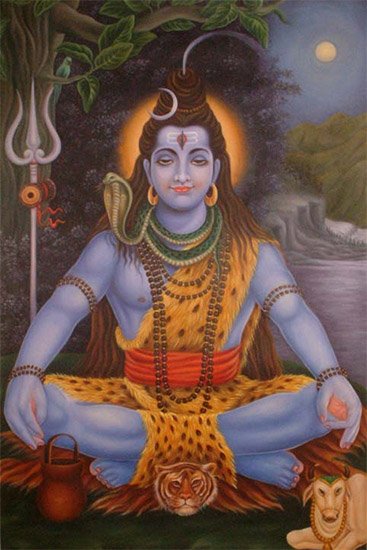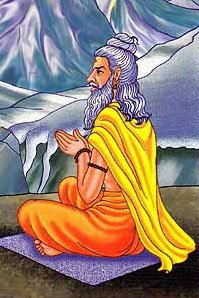Vrisharudha, Vṛṣārūḍha, Vrisha-arudha: 3 definitions
Introduction:
Vrisharudha means something in Hinduism, Sanskrit. If you want to know the exact meaning, history, etymology or English translation of this term then check out the descriptions on this page. Add your comment or reference to a book if you want to contribute to this summary article.
The Sanskrit term Vṛṣārūḍha can be transliterated into English as Vrsarudha or Vrisharudha, using the IAST transliteration scheme (?).
In Hinduism
Shaivism (Shaiva philosophy)
Source: Shodhganga: Iconographical representations of Śiva1) Vṛṣārūḍha (वृषारूढ) or Vṛṣārūḍhamūrti refers to one of the twenty-three forms (mūrti) of Śiva mentioned in the Pūrvakāmikāgama (pratimālakṣaṇavidhi-paṭala): first and foremost among the Mūlāgama. The forms of Śiva (e.g., Vṛṣārūḍha) are established through a process known as Sādākhya, described as a five-fold process of creation.
2) Vṛṣārūḍha is also listed among the twenty-eighth forms (mūrti) of Śiva mentioned in the Vātulāgama: twenty-eighth among the Siddhāntaśaivāgama.
3) Vṛṣārūḍha is also listed among the eighteen forms (mūrti) of Śiva mentioned in the Kāraṇāgama (pratimālakṣaṇavidhi-paṭala): the fourth among the Siddhāntaśaivāgamas.
4) Vṛṣārūḍha is also listed among the ten forms (mūrti) of Śiva mentioned in the Ajitāgama (under the Raudrarūpa heading): the fifth among the Siddhāntaśaivāgamas.
5) Vṛṣārūḍha is also listed among the sixteen forms (mūrti) of Śiva mentioned in the Dīptāgama: the sixth among the Siddhāntaśaivāgamas.
6) Vṛṣārūḍha is also listed among the twelve forms (mūrti) of Śiva mentioned in the Suprabhedāgama: the tenth among the Siddhāntaśaivāgamas.
Source: SOAS University of London: Protective Rites in the Netra Tantra1) Vṛṣārūḍha (वृषारूढ) refers to “being mounted on a very strong bull” and is used to describe Tumburu, according to the Netratantra of Kṣemarāja: a Śaiva text from the 9th century in which Śiva (Bhairava) teaches Pārvatī topics such as metaphysics, cosmology, and soteriology.—Accordingly, [verse 11.1-24ab, while describing the appearance and worship of Tumburu]—“[...] [Tumburu is] white like a drop of frosty jasmine, similar to mountain snow. [He wears] a serpent as a sacred thread and is adorned with snake ornaments. [Tumburu is] adorned with all jewels, a tiger skin on the ground [below his] hips, a garment of elephant skin, mounted on a very strong bull (vṛṣārūḍha—vṛṣārūḍhaṃ mahābalam), and wears a rhino hide. [...]”.
2) Vṛṣārūḍha (वृषारूढ) or “(being) mounted on a man” and is used to describe Rudra.—Accordingly, [verse 13.29-36, while describing the appearance and worship of Rudra]—“Assuming the form of Rudra, [Amṛteśa holds] a dazzling white conch shell bowl. [Rudra has the] form of Sadāśiva [and the Mantrin] visualizes [him] with four arms, mounted on a man (vṛṣārūḍha). [...]”.

Shaiva (शैव, śaiva) or Shaivism (śaivism) represents a tradition of Hinduism worshiping Shiva as the supreme being. Closely related to Shaktism, Shaiva literature includes a range of scriptures, including Tantras, while the root of this tradition may be traced back to the ancient Vedas.
Purana and Itihasa (epic history)
Source: archive.org: Shiva Purana - English TranslationVṛṣārūḍha (वृषारूढ) refers to “being seated on a bull” and is used to describe Śiva, according to the Śivapurāṇa 2.3.41 (“Description of the Altar-Structure”).—Accordingly, as Brahmā narrated to Nārada: “[...] Then you were a bit confused and greatly bewildered. You spoke to the lord of mountains thus.—‘O lord of mountains, tell me the truth. Has lord Śiva seated on his bull (vṛṣārūḍha) and surrounded by his Gaṇas come already for the marriage? Have the gods with Viṣṇu and others at their head, the sages, the Siddhas and the secondary gods come already?’ [...]”.

The Purana (पुराण, purāṇas) refers to Sanskrit literature preserving ancient India’s vast cultural history, including historical legends, religious ceremonies, various arts and sciences. The eighteen mahapuranas total over 400,000 shlokas (metrical couplets) and date to at least several centuries BCE.
See also (Relevant definitions)
Partial matches: Vrisha, Arudha, Aruta.
Starts with: Vrisharudhamurti, Vrisharudhapratishtha.
Query error!
Full-text: Vrisharudhapratishtha, Vrisharudhamurti, Trimurtisthapana, Guhasthapana, Vishnumardhapratishtha, Vishnumardha, Vishnuma, Gangadharapratishtha, Candeshasthapana, Shivabhaktapratishtha, Mahabala.
Relevant text
Search found 8 books and stories containing Vrisharudha, Vrisha-arudha, Vṛṣa-ārūḍha, Vrsa-arudha, Vṛṣārūḍha, Vrsarudha; (plurals include: Vrisharudhas, arudhas, ārūḍhas, Vṛṣārūḍhas, Vrsarudhas). You can also click to the full overview containing English textual excerpts. Below are direct links for the most relevant articles:
Prayogamanjari and Saivagamanibandhana (Study) (by R. Suthashi)
Description of Vrisharudha-Murti < [Chapter 4 - Anthropomorphic forms of Shiva in Kerala Tantric works]
Talabheda—Different measurements < [Chapter 3 - Shaiva iconography in Saivagamanibandhana]
Brihad Bhagavatamrita (commentary) (by Śrī Śrīmad Bhaktivedānta Nārāyana Gosvāmī Mahārāja)
Verse 2.3.49 < [Chapter 3 - Bhajana (loving service)]
Sucindrasthala-mahatmya (critical edition and study) (by Anand Dilip Raj)
Chapter 5 - Pancama Adhyaya (pancamo'dhyayah) < [Chapter 5 - Sucindrasthalamahatmya: Sanskrit critical edition]
Skanda Purana (by G. V. Tagare)
Chapter 77 - Puṣpadanteśvara (puṣpadanta-īśvara-liṅga) < [Section 2 - Caturaśīti-liṅga-māhātmya]
Isanasivagurudeva Paddhati (study) (by J. P. Prajith)
1. The Concept of Devatas in Hinduism < [Chapter 3 - Depiction of Gods and Goddesses]
Vishnudharmottara Purana (Art and Architecture) (by Bhagyashree Sarma)
8(b): The Image of Various Gods < [Chapter 5 - Painting and Image Making]